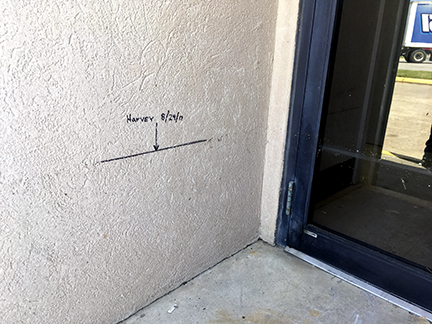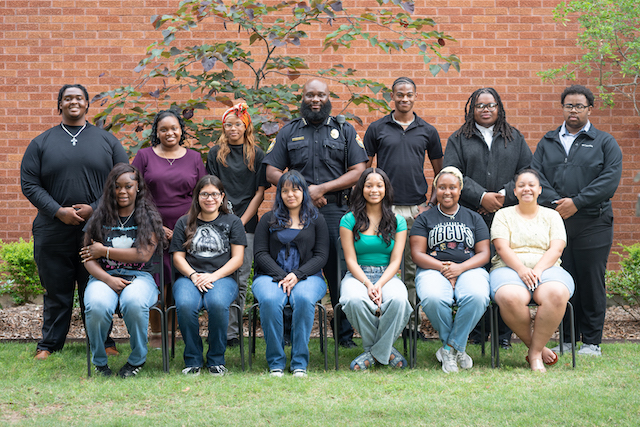Pumps worked throughout storm, though one ran out of fuel temporarily
Published 3:17 pm Friday, September 8, 2017

- X marks the spot: Drainage district employees mark the high water mark from Harvey.
The water spared no one.
On Friday, the offices of Drainage District Seven on 9th Avenue stood empty. Chairs sat, drying in the parking lot. They were still wet from the floodwater of a week ago.
Drainage District Seven is the agency responsible for flood control through a series of wastewater pumps and levees, and during the historic flood last week, the agency was the source of a lot of speculation by people on social media.
Manager Phil Kelley said he’s not on Facebook, but he still heard about it.
“We were pumping, despite all the Facebook fake news,” he said. “We were pumping virtually wide open, and we got hit again and we lost ground.”
That was on Aug. 28.
A day earlier members of Kelley’s staff, who man the pump stations, went on 12-hour shifts, meaning someone would be at each station 24-hours a day. But, after days of nonstop rain, the schedule was looking tenuous. As water rose throughout the city, some pump stations could not be reached—or evacuated—as the water was too high.
All night long the rain came down.
“Throughout the night, it inundated this whole watershed to the point that our guys, we couldn’t change our shift over because the people who were in the pump stations couldn’t get out, and the people who needed to get to work couldn’t get there and by that time, families were getting rescued and at that point, our schedule went out the window,” Kelley said.
As the morning of Aug. 29 dawned, the city was downing and 12-hour shifts were sliding toward the 24-hour mark and the workers in the pump stations continued their operations even as the water started to rise inside some of the stations.
“They started getting scared,” Kelley said. “All I could do is get a message to them to grab you some food and your phone and get high in the building and sooner or later, we’ll get you,” he said.
Sooner or later.
“Well, some people probably (worked) as long as 36 hours I would think,” Kelley said. “We were so spread out with our resources.”
Then the stations began to run low on diesel.
“We were running low on diesel fuel and thanks to Judge (Jeff) Brannick and Greg Fountain, the emergency management coordinator for the county, they were working hard for us.”
Finally, the National Guard arrived with diesel, but not before one pump station, at Crane Bayou, near the Proctor Street extension, ran dry.
“But that was later,” Kelley said. “We couldn’t get to it. The trucks couldn’t get to it, the water was too high.”
The one bright spot for the drainage district was the levee. Several weeks prior to the storm, someone noticed a tear in the levee near Taylors Bayou. Several days prior to Hurricane Harvey making landfall, workers were still busily seeking to shore up the sea wall with sandbags.
They were successful—the seawater stayed in the sea. It was the rainclouds that were a problem this time.
Kelley said he takes rain measurements from around the county.
“From the very beginning, which was Aug. 25, to Aug. the 31, we recorded in excess of 60 inches of rain at two locations. Everywhere else ranged from 35 to 45 to 50 inches of rain,” he said. “And 65 inches of rain is our annual rainfall.
“That storm just sat right here and poured on us. It was something I hope I never see again.”
Even so, Kelley said he is hoping federal funding will pay for improvements to the drainage infrastructure so, if it does happen again, the city will be prepared.
“There are usually hazard mitigation grants that come down, and we will be proactive in seeking hazard mitigation grants,” he said.
Now that the floodwaters have receded, the drainage district offices are, like many offices and homes in the city, getting reorganized. Kelley said they will relocate to the old Community Bank building on Twin City Highway.
Kelley is also reflecting on the storm, on what he saw and how it stacks up against other hurricanes.
“We’ve been through two hurricanes prior to this,” he said. “Neither storm dumped near this amount of rain. We might have gotten seven-to-10 inches of rain in those two hurricanes. This event was a historical event. When you get your annual rainfall in a week’s time, that’s certainly impressive.
“After Rita we learned a lot. What I learned from Harvey is, you just absolutely cannot prepare for that. I don’t care how much mitigation you do to prevent something like that from happening. Personally, I don’t think there’s enough money in the world to prepare for something like that.”





